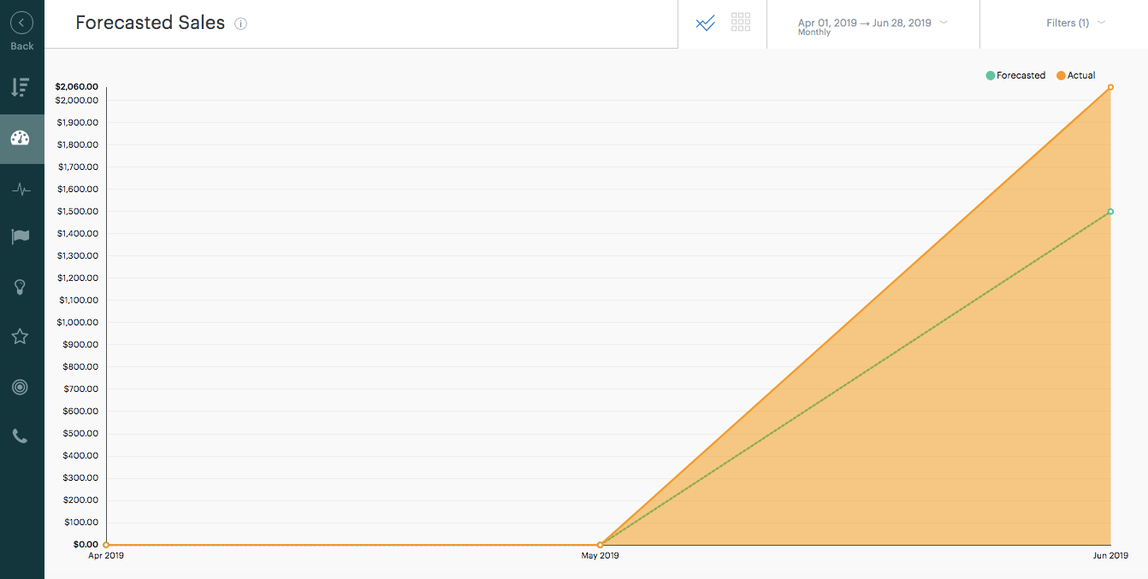Article • 8 min read
Five ways to boost and measure sales productivity
From closely watching sales pipeline progress to prioritizing tasks, implementing a few tested tactics will help your team close more deals.
Lauren Funk
Measuring sales productivity has always been an important activity for sales managers. Now that businesses are more data-driven, it is even more crucial for every sales team to have effective productivity tracking practices.
It can be helpful to think of measuring sales productivity as a part of the overall sales enablement process, in which a team is provided the tools and information needed to drive efficiency and total sales. Fortunately, it doesn’t have to be hard to implement measures that show where your reps are wasting time, and where they should put more energy to get the most out of every minute they spend selling.
Let’s dive into five ways for measuring sales productivity that are backed by sales experts — individuals with years of sales experience including sales authors, strategists, CEOs, coaches, and founders.
Measure the number and quality of customer interactions
Review Activity Reports in your CRM
While many reps may go through the motions of talking with lots of prospects (for example, high dials), are your reps having enough meaningful conversations that will lead to a sale?
According to Wendy Weiss, president of ColdCallingResults.com, “The metrics that are important to measure for telephone prospecting are: Dials, Conversations (with a qualified prospect) and Appointments. Many sales professionals will track their number of Appointments, some will track their Dials and Appointments, but very few track the number of Conversations they’re having with qualified prospects. Without that middle number, it’s impossible to know how you’re doing.”
A sales leader needs to monitor the quality of each potential customer conversation. Numbers are meaningless if you’re not building relationships and driving sales. “To me, quality is my most important productivity tool,” says author, speaker, and strategist Jill Konrath. “I want to have maximum impact with every client interaction, keeping my prospect moving forward. If that didn’t happen, I need to revisit my planning, knowledge, strategy, approach, messaging and more.”
Productivity measures: Track calls, emails, and meeting metrics in your CRM. Sell generates reports based on these activities. For example, you can see the number of calls, call duration, call length vs. time of days, as well as call outcomes — important to know if calls are high quality and effective. If you’re a sales manager, you can sort this info by sales rep. Some reps might have better call outcomes than others. Pair these reps with the ones who need help with their sales effectiveness.
Pay attention to sales pipeline progress

Check opportunities in each stage of the sales pipeline.
If your reps only have a general idea of pipeline opportunities, that’s not a good productivity sign. The number of opportunities should be carefully monitored as each stage indicates what revenue you’ll have at the end of the quarter. Tracking the progress of sales stages also highlights what skills reps need to improve.
As Lori Richardson, founder and CEO of Score More Sales, explains, “A productivity metric every salesperson should be paying attention to is number of opportunities prospected to qualified to closure. That’s really three metrics, but I want to see what a rep started with (to know if they have enough of the right activity while prospecting), what they move through as “qualified” in the pipeline (so I know if they are spending time in the right places), and then of those qualified, how many came to closure – so that I can tell if they are working the right opportunities or if there are other issues, such as lack of urgency or poor messaging.”
This productivity tip goes back to creating a quality sales pipeline. It might go without saying, but your reps need to generate enough quality leads early on to increase the chance of closing more deals. “If you are not making contact with new people constantly, I don’t care how good you are at asking for the sale, overcoming objections, questioning or anything else,” sales, marketing and business coach Butch Bellah says, “You’re not going to have anyone to talk to.”
Productivity measures: Review the number of opportunities at each stage of the sales pipeline management to check for any bottlenecks and to make improvements, if needed. Ensure that reps are generating enough leads to move through the pipeline. Also, check if these leads match with buyer personas. For example, if certain reps have a large number of prospects, but are failing to move them to the Qualified stage, you might need to revisit your customer qualification requirements. Deal loss reason, average lead response time, closing ratio, and customer acquisition cost are sales pipeline metrics to keep a close eye on.
Evaluate whether you’re meeting your sales forecast

Sell’s CRM “Forecasted Sales” report
Sales forecasting assists with more than just estimating final numbers — it provides a baseline for reps to see if they’re on track to meet goals and if their skills need improving.
As Jeff Sheehan, coauthor of “Hired! Paths to Employment in the Social Media Era,” explains, “No matter how you might want to slice and dice it, the number one measure for sales is the amount of revenue which is generated versus that forecasted. Is the salesperson meeting his or her plan? If so, at what percentage to plan? Any deviations need to be thoroughly explained and corrective actions taken to ensure that the person gets back on track during the upcoming month, quarter, or other reporting period.”
7 secrets of sales leadership
Read the full list of sales leader secrets to find out how these managers are getting the most from their teams.
Work backward from your sales forecasts to determine if you or your reps are on track to meet their quota. “Reflect upon how many sales are required, the most likely candidates who will purchase, and the prospecting required to keep the pipeline filled at all times,” says Elinor Stutz, CEO, Smooth Sale. “Come to terms with the number of contacts required, and dedicate yourself to the task in order to make the ultimate sales reality.”
Productivity measures: Review your sales reports. What is your forecasted revenue at the end of the quarter? How many deals will you need to close to meet this goal? For example, maybe you determine that you have a quota of 25 deals to close at CRM software and must win at least 50% of deals in your pipeline to reach that number. Your CRM should show if these goals are being met. If not, break down the numbers to understand what activities you or your reps need to complete to meet the quota long before the end of the quarter.
Track your thank-you notes

Productivity is not just about the hard numbers. It’s also about how a sales representative nurtures relationships with prospects. A handwritten note is one way to approach customer nurturing (and a great way to stand out from other reps who only send emails). Compose personal notes that show your appreciation for the prospect or customer.
According to Craig Wortmann, founder & CEO, Sales Engine,“I closely track how many thank-you notes I write to people, because for me that’s a lagging indicator of productivity. If I’m generating leads and pushing those leads into the sales process, chances are that I’ve now got someone to thank. And as I’ve said a million times, a “thank-you” is only a thank-you if it’s done properly. An email will not suffice. So I use tags to measure how many notes I’ve written and mailed in a given month.”
Productivity measures: Keep up with the number of thank-you notes written by the month. This could be a thank-you note after a sales meeting, a close, or a customer referral. Categorize notes by sales stages or by customer type. If you’re a sales manager, review how many notes your reps are sending and how many deals/relationships this translates to.
Prioritize your selling tasks

Prioritize your sales tasks through your CRM.
Jumping from one sales activity to the next can be deceiving — it might look productive, but in reality, your reps could just be spinning their wheels without actually moving high-quality prospects forward. Prioritization can help with this problem.
“When it comes to my own productivity, I focus on results,” says Jim Keenan, founder, A Sales Guy Consulting, “I find measuring time and productivity to be counterproductive. Measuring individual productivity takes me away from what I should be doing. With that said, to ensure I’m being productive, I prioritize my tasks and initiatives to make sure I know what is most important and only work on those things.”
Productivity measures: Use your CRM to organize sales activities, conversations, and calendar. For example, with a sales productivity tool like Sell, you can input tasks and sort by different filters such as due date to know which tasks to focus on. If you’re a sales manager, you can track the tasks of your sales rep by owner. If you want to know what customer conversations to prioritize, head to the Communication Center. For example, with emails, you can refine results by “Hot Deals.”
Effectively measuring sales productivity
If you’re unsure how productive your sales team actually is, take our sales productivity to find out. Once you have solid productivity processes in place, use the above measures to understand what activities you need to focus on, as well as provide clear objectives for your sales organization. As you improve measuring sales productivity and the process, you increase the chance of higher sales!
